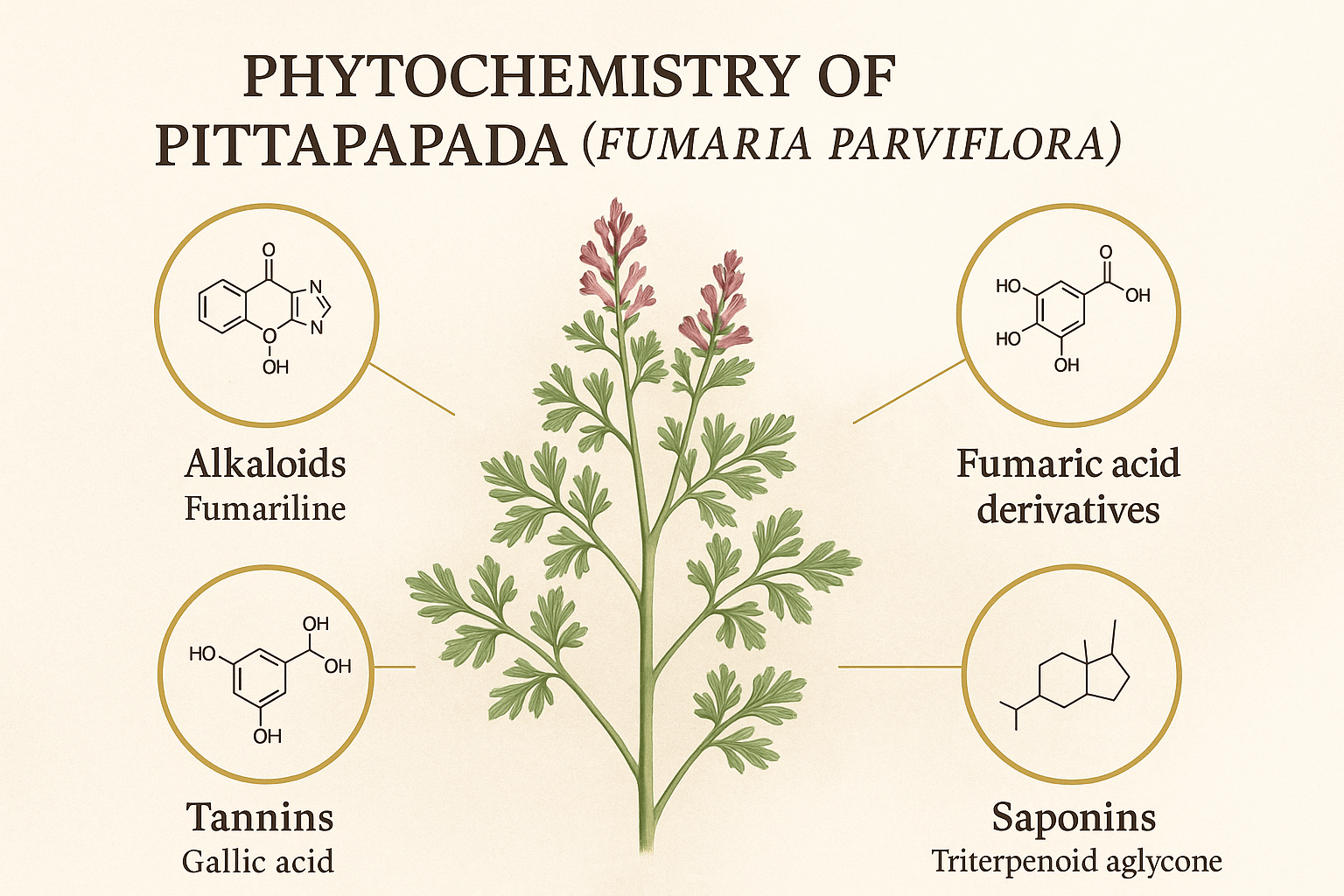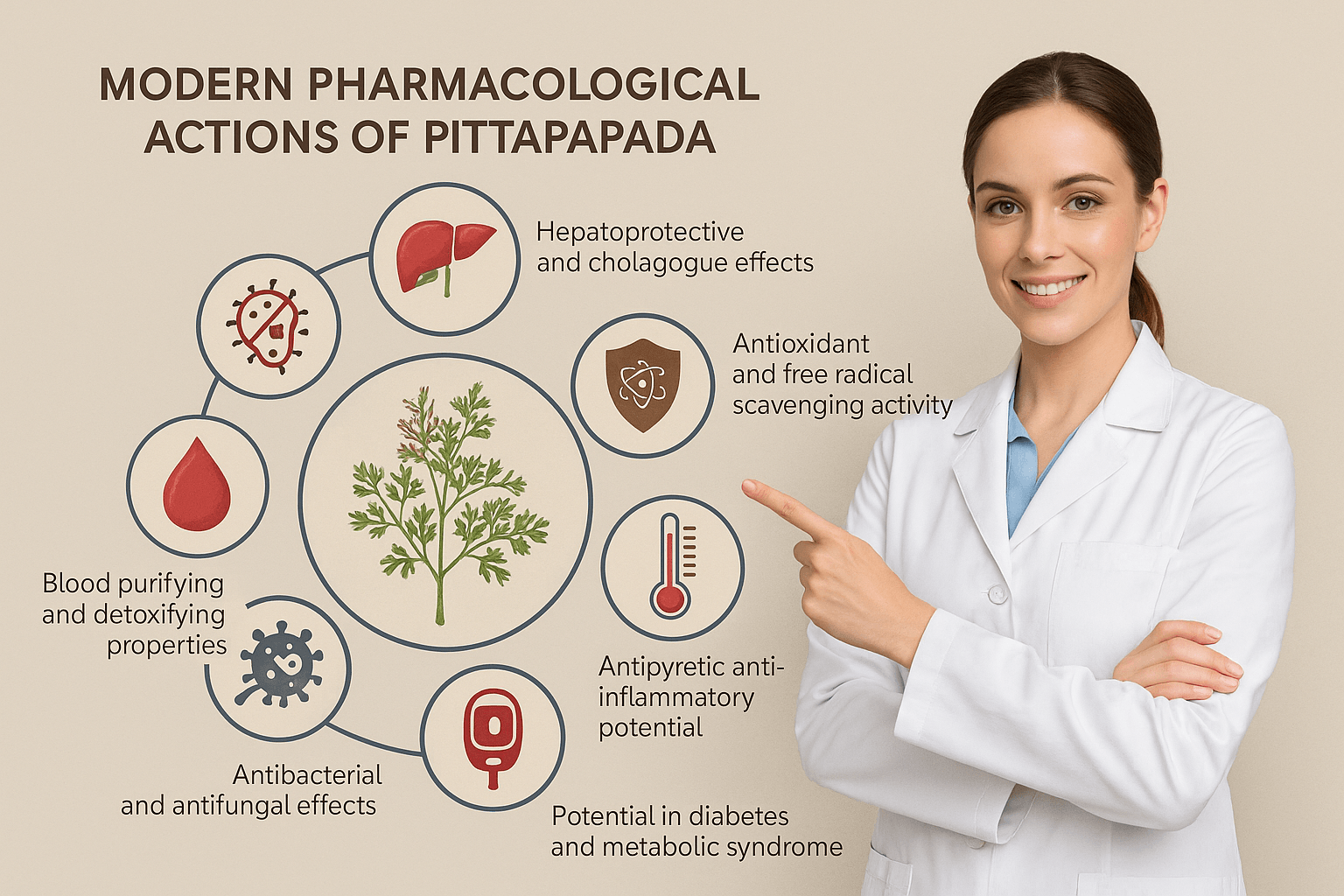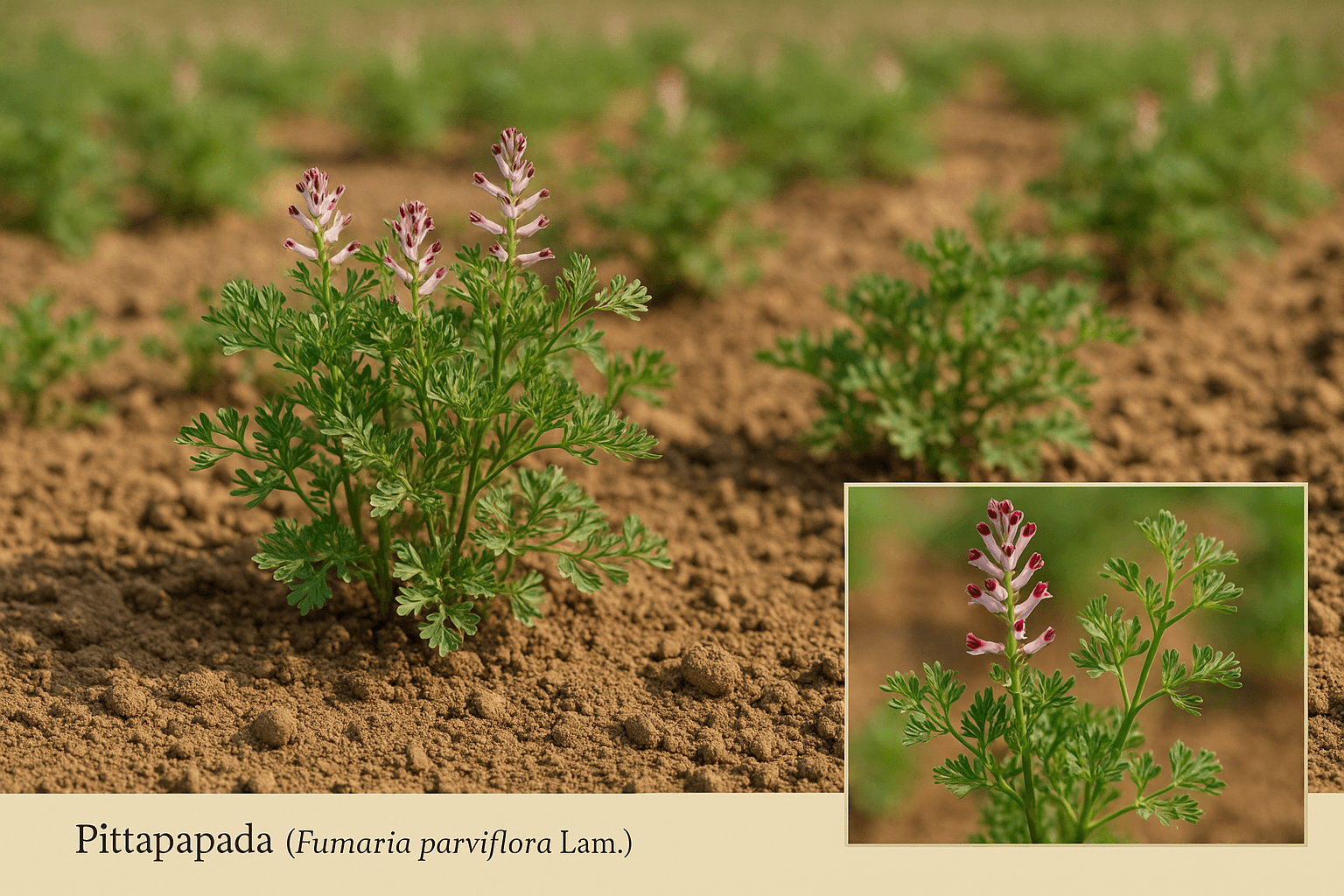- Introduction and Names
- Description
- Properties, Defects and Effects-Ayurvedic Opinion-According to Nibindu Ratnakar
- Ayurvedic Classification
- Chemical Analysis
- Phytochemistry
- Unani Medicines Belief:
- Caution
- Antidote
- Preparation
- Ayurvedic Therapeutic Uses
- Raktapitta (Bleeding Disorders)
- Jwara (Fever)
- Yakrit Vikara (Liver Disorders, Jaundice, Hepatitis)
- Kushtha (Skin Diseases, Eczema, Psoriasis)
- Amlapitta (Hyperacidity, Gastritis)
- Mutrakricchra (Urinary Disorders)
- Aruchi and Agnimandya (Loss of Appetite, Weak Digestion)
- Pandu (Anemia)
- Shotha (Edema and Inflammation)
- Kasa–Shwasa (Cough and Asthma)
- Krimi (Parasitic Infestations)
- Arsha (Hemorrhoids)
- Netra Roga (Eye Disorders)
- Modern Pharmacological Actions
- Dosage and Administration
- Frequently Asked Questions (FAQ)
- References
Introduction and Names
- Non-Sanskrit Names: Parpat, Baratikta, Arka, Charka, Kalpanga, Katupatr, Kavachanamak, Krishnashastra, Pashuparyaya, Pragasva, Pittari, Shitavallabha, Sutikta, Trishnari, Chipdi, among others.
- Hindi Name: Pittapapada, Shahtara.
- Persian Name: Shahtara.
- Bengali Name: Vansulka.
- Gujarati Name: Pittapapada, Barsalia.
- Tamil Name: You.
- Telugu Name: Chatrasi.
- Urdu Name: Shahtara.
- Latin Name: Fumaria parviflora.
Description
Pittapapada plants thrive abundantly during the rainy season. They typically grow just above ground level, spreading their branches outward in all directions. In fertile soil, especially near floodplains or under the cover of other shrubs, the plant can reach up to 1 foot tall. However, when grown in open areas, it tends to spread across the ground. The leaves range from half an inch to 2 inches long and about five inches wide, forming dense clusters on either side of the stem. Its branches can grow up to 6 inches long, with pinkish flowers featuring a subtle purple shade. The fruit, resembling lentil seeds, appears blue or brown in color. The entire plant produces white flowers, and it has a bitter smell and taste. Interestingly, there are two main varieties of Pittapapada. One, called Shahtara, originates from Iran, and the other, Pittapapada, is native to this region. The Iranian variety is often considered superior in quality.
Properties, Defects and Effects-Ayurvedic Opinion-According to Nibindu Ratnakar
According to Ayurvedic opinion and Niantu Ratnakar, Pittapapada is described as a cooling, bitter, and light herb. It helps with constipation, is easy to digest, and aids in balancing finances, phlegm, fever, and blood disorders. Additionally, it is effective in relieving loss of appetite, burning sensations, confusion, and mental unrest. Pittapapada is particularly known for calming conditions like Mada, Premah, vomiting, thirst, and bleeding disorders. The branches of Pittapapada offer anti-stool properties, act as cooling agents, and are mildly bitter. They are effective in treating blood diseases, bile disorders, fever, cough, and burning sensations.
Botanical identity and synonyms
Pittapapada, botanically identified as Fumaria parviflora Lam., belongs to the family Papaveraceae. It is commonly known in English as common fumitory or fine-leaved fumitory, and in Ayurveda it is referred to as Shatpapada due to its delicate, divided leaf structure resembling numerous small feet. In Unani medicine, it is called Shahtrah, while in regional Indian languages it carries names such as Pitpapra (Hindi) and Pitpapado (Gujarati).
Classical Ayurvedic categorization
Ayurvedic nighantus (lexicons) such as Bhavaprakasha Nighantu (Haritakyadi Varga, verse 176–177) describe Pittapapada as a potent Pitta-shamaka dravya (herb that pacifies Pitta dosha) and a natural blood purifier. It is traditionally placed in the category of Raktaprasadana (blood-cleansing herbs) and Yakrit-vikara prashamana (liver-protective drugs). The herb is also mentioned in Raja Nighantu under the Oshadhi Varga for its utility in conditions like Raktapitta (bleeding disorders), Jwara (fever), and Kushtha (skin diseases).
Historical use in Ayurveda, Siddha, and Unani systems
In Ayurveda, Pittapapada has been valued for centuries as a detoxifying herb used in fever, bleeding disorders, jaundice, and skin ailments. In Siddha medicine, it is incorporated into formulations for treating liver congestion and skin eruptions, often prescribed as decoctions and powders. In the Unani system, Shahtrah is considered a primary blood purifier and liver tonic, widely used for dermatological diseases, chronic fevers, hepatic dysfunction, and inflammatory conditions. Its cross-cultural acceptance highlights its unique role as a traditional detoxifier with strong hepatoprotective and dermatological applications.
Ayurvedic Classification

Rasa (Taste): Pittapapada is described as having a Tikta (bitter) and Kashaya (astringent) rasa. These tastes are closely linked with its ability to pacify excessive Pitta and purify the blood, making it useful in disorders like jwara (fever), raktapitta (bleeding disorders), and kushtha (skin diseases).
Guna (Qualities): It is Laghu (light) and Ruksha (dry) in guna, which contribute to its cleansing, detoxifying, and anti-kapha properties. These qualities help reduce excessive moisture and sliminess in the body channels, making it effective in conditions like hyperacidity, jaundice, and urinary disorders.
Virya (Potency): The herb is classified as having Ushna virya (hot potency). This ushna effect enhances agni (digestive fire), counteracts excessive coldness and dampness in the body, and helps break down toxins (ama).
Vipaka (Post-digestive Effect): Its Katu vipaka (pungent post-digestive effect) supports digestive metabolism, clears channels (srotas), and prevents kapha accumulation in the gastrointestinal tract.
Doshic Action: Pittapapada is renowned as a Pitta-shamaka (pacifier of Pitta dosha) and Kapha-shamaka herb. It also supports the balance of Rakta dhatu (blood tissue), making it especially useful in conditions of dushta rakta (vitiated blood), inflammatory disorders, and liver dysfunctions.
Classical References:
- Bhavaprakasha Nighantu (Haritakyadi Varga, verse 176–177) – describes Pittapapada as beneficial in fever, burning sensations, bleeding disorders, and skin ailments.
- Charaka Samhita (Chikitsa Sthana, 4th chapter – Jwara Chikitsa) – mentions similar bitter-astringent herbs for balancing Pitta and blood purification, a category where Pittapapada is traditionally grouped.
Raja Nighantu (Oshadhi Varga) – highlights its use in jwara, raktapitta, kushtha, and yakrit vikara (liver disorders), reinforcing its role as a classical detoxifying and hepatoprotective herb.
Chemical Analysis
Chemical analysis reveals that Pittapapada contains an acidic substance and alkali, with about 6% alkali present. The alkali in this plant is key to its medicinal properties, as it exits through the skin, liver, and kidneys, making Pittapapada a diaphoretic, diuretic, and bitter but nutritious herb. It is especially beneficial in treating indigestion caused by intestinal dysfunction. Pittapapada has been renowned in India since ancient times for its ability to calm bile-related disorders. It is particularly useful for conditions where pitta (bile) is dominant, such as malarial fever. This herb purifies the blood by inducing sweat, helping to reduce the heat of fever and redness in urine. Pittapapada also alleviates head heat, severe headaches, and burning sensations in the hands, feet, and eyes. It reduces the weakness that comes after fever and helps clear urine. By consuming this herb as an icy beverage, various fever-related ailments are relieved.
Phytochemistry

Pittapapada is a chemically diverse herb containing alkaloids, fumaric acid derivatives, flavonoids, tannins, and saponins. These groups of compounds give it hepatoprotective, detoxifying, antioxidant, and immunomodulatory properties, validating its traditional Ayurvedic use in fevers, liver disorders, and skin diseases [1].
Major Alkaloids
The most important chemical constituents of Pittapapada are isoquinoline alkaloids such as Fumariline (C₁₉H₁₉NO₄), Fumarin (C₁₅H₁₃NO₄), and Fumaridine (C₂₀H₂₁NO₄). These alkaloids exhibit bitter-astringent taste, matching its Ayurvedic classification of Tikta-Kashaya rasa. Pharmacological studies demonstrate that these compounds stimulate bile secretion and support enzymatic detoxification processes in the liver [2]. They also regulate hepatic oxidative balance and reduce toxic load, confirming the herb’s classical designation as a yakrit-vikara prashamana dravya (liver-protective drug).
Fumaric Acid Derivatives
Pittapapada contains fumaric acid (C₄H₄O₄) and related esters, which are intermediates in the Krebs cycle and play roles in cellular energy metabolism. Modern pharmacological interest in fumaric acid derivatives has increased due to their ability to reduce oxidative stress, modulate immune activity, and downregulate inflammatory cytokines [3]. In clinical practice, fumaric acid esters are already used in dermatology for autoimmune skin disorders like psoriasis, which reflects Pittapapada’s traditional use in kushtha and rakta dushti in Ayurveda. This biochemical link reinforces the bridge between Ayurvedic observations and modern pharmacology.
Flavonoids
Flavonoids present in the plant include quercetin (C₁₅H₁₀O₇), kaempferol (C₁₅H₁₀O₆), and rutin (C₂₇H₃₀O₁₆). These polyphenolic compounds are known antioxidants and free radical scavengers [4]. They enhance vascular stability, reduce capillary fragility, and support anti-inflammatory pathways. In Ayurveda, Pittapapada is used for rakta-shuddhi (blood purification), which is consistent with flavonoids’ ability to protect erythrocytes and vascular endothelium. Flavonoids also play a role in enhancing hepatic antioxidant defense, complementing the alkaloid fraction in hepatoprotection.
Tannins
Tannins in Pittapapada are polyphenolic compounds derived from gallic acid (C₇H₆O₅) and ellagic acid (C₁₄H₆O₈). These compounds impart the astringent effect described in Ayurvedic texts as Kashaya rasa [5]. Tannins form protective complexes with proteins on mucosal surfaces, reducing excessive secretions in conditions such as diarrhea, hyperacidity, or bleeding disorders. Their antimicrobial and wound-healing properties also correlate with Pittapapada’s use in skin diseases and gastrointestinal disorders.
Saponins
Saponins are glycosidic compounds with a triterpenoid or steroidal aglycone core. A general molecular formula for triterpenoid saponins is C₃₀H₅₀O₂. These amphiphilic molecules reduce surface tension and have detergent-like properties that facilitate cleansing and detoxification [6]. In vivo, they support immune modulation, improve nutrient assimilation, and promote clearance of metabolic wastes (ama). Their adaptogenic potential explains why Pittapapada has been used across Ayurveda, Siddha, and Unani for systemic detoxification.
Role of Isoquinoline Alkaloids in Hepatoprotection
Among all constituents, the isoquinoline alkaloids stand out for their hepatoprotective efficacy. Studies on experimental liver toxicity models, including carbon tetrachloride (CCl₄)-induced hepatic injury, show that extracts of Pittapapada containing these alkaloids prevent hepatocyte necrosis, normalize liver enzymes, and restore bile flow [7]. This strongly validates the classical Ayurvedic prescriptions of Pittapapada in jaundice, fevers with hepatic involvement, and rakta-pitta disorders [8].
Unani Medicines Belief:
Unani Perspective – Unani practitioners believe that this plant possesses a bitter and slightly sour-sweet taste. It acts as a diuretic, improves digestion, cures blood and skin diseases, strengthens the lungs and teeth, purifies the eyes, stops vomiting, and benefits the spleen.
Dry Pittapapda proves useful in treating chronic fever, air-related diseases, and jaundice. It also eliminates vomiting and nausea, increases urination, and stimulates appetite. When applying a paste of fresh Pittapapda, it becomes particularly beneficial for honey bee stings.
However, Pittapapda negatively affects the spleen and heart. For this reason, combining it with Badi Harad works well, as Badi Harad neutralizes its harmful effects.
Pittapapda purifies and thins the blood. Grinding it with henna leaves and massaging it over the entire body relieves both wet and dry itching. Furthermore, by adding sugar to its juice, you can make a syrup that eliminates bodily impurities and brain defects. If you also mix Badi Harad into this syrup, it becomes especially potent.
Applying its juice to the eyes enhances vision and promotes tear flow to cleanse the eyes. Interestingly, if you uproot parwal (pointed gourd) from the fire, fill its roots with Pittapapda juice mixed with a bit of gum, hair growth in that area ceases.
Gargling with its decoction strengthens the gums and heals tongue and palate wounds, effectively reducing heat in the mouth and tongue.
Pittapapda also strengthens the stomach, but using the dried version yields better results. Taking it with alcohol enhances stomach strength, while consuming it with vinegar boosts appetite and curbs nausea and phlegm. Extracting it from the fire brings further benefits. Its use clears stench from the liver and spleen.
Caution
Caution – Excessive consumption of Pittapapda can harm the spleen, kidneys, and heart, and may cause restlessness.
Antidote
Antidote – To counter its effects, Badi Harad, honey, and lemon help with spleen and kidney issues, while plums are effective against restlessness. The recommended amount of powder ranges from 6 to 10 majhas, and fresh juice should be consumed between 1 to 10 tolas (11,660 to 116,600 milligrams).
Preparation
Preparation – For Pittapapdaadi Arishta, mix 400 tola (4,664 grams or 4,664,000 milligrams) Pittapapda with 1024 tola (11,942 grams or 11,942,000 milligrams) of water and boil it until 256 tola (2,987 grams or 2,987,000 milligrams) of water remains. After filtering it, add 800 tola (9,328 grams or 9,328,000 milligrams) of old jaggery and 64 tola (746 grams or 746,000 milligrams) of Dhawadi flower powder along with Giloy, Nagar Mosha, Daruhaldi, Teliyadevdar, Bhori-Gani, Ghamasa, Chavya, Chitrak Ki Jai, dry ginger, chili, pepper, and Byabidang. Use 4 tola (46.64 grams or 46,640 milligrams) of each of these powders. Fill ceramic jars with this mixture, seal the jars, and let them sit for one month. Afterward, filter the Arishta and use it.
To use, mix 1 to 2 tolas (11,660 to 23,320 milligrams) of this Arishta with four times water and drink it in the morning and evening. This remedy cures all types of chronic and intermittent fevers, along with anemia, jaundice, and the swelling and enlargement of the spleen and liver caused by these conditions.
Ayurvedic Therapeutic Uses

Raktapitta (Bleeding Disorders)
Pittapapada is highly regarded in Ayurveda as a rakta-prasadana dravya (blood-purifying herb) and pitta-shamaka medicine. In conditions of raktapitta, which includes bleeding from the nose, gums, gastrointestinal tract, or uterus, this herb balances aggravated pitta and improves the integrity of blood vessels. Its tikta (bitter) and kashaya (astringent) tastes act to cool, constrict, and cleanse the blood, while its ushna virya prevents stagnation of toxins. Classical references recommend it in nasal hemorrhage, excessive menstrual bleeding, and blood-streaked stools. From a modern perspective, the presence of tannins and flavonoids explains its hemostatic activity, as these compounds strengthen vascular walls and reduce capillary fragility. Additionally, its detoxifying effect helps reduce inflammatory mediators that worsen bleeding. Thus, Pittapapada offers a twofold benefit: cleansing impurities from the blood while reducing excessive discharge. Its regular use in decoctions or powders has been a cornerstone in both Ayurvedic and Unani practice for centuries [1].
Jwara (Fever)
Ayurvedic texts list Pittapapada among important herbs for pitta-jwara, a fever type associated with burning sensation, thirst, irritability, and skin eruptions. Its bitter principles act as natural antipyretics, reducing body heat and supporting toxin clearance. The herb’s ushna virya enhances agni (digestive fire), ensuring that ama (undigested metabolic waste) does not accumulate, which is considered a root cause of recurrent fever. Traditionally, decoctions of Pittapapada were administered during epidemic fevers and seasonal febrile outbreaks, often combined with herbs like Guduchi and Nimba. Modern pharmacological studies confirm its antipyretic and anti-inflammatory actions, mediated by isoquinoline alkaloids that regulate inflammatory pathways. This validates why it was prescribed for both acute fevers and chronic low-grade febrile conditions linked to liver dysfunction. In integrative practice today, Pittapapada may complement fever management by reducing inflammation, protecting the liver, and modulating immune response. This makes it relevant for conditions like viral fevers, malaria-like states, and post-infective inflammation [2].
Yakrit Vikara (Liver Disorders, Jaundice, Hepatitis)
In Ayurveda, Pittapapada is classified as a yakrit-vikara prashamana dravya, a corrective herb for liver dysfunctions. It is frequently prescribed in kamala (jaundice) and pandu (anemia), both of which are associated with pitta imbalance and rakta dushti. By virtue of its bitter taste and katu vipaka, it enhances bile flow, clears ama, and restores normal hepatic metabolism. Classical formulations often included Pittapapada in decoctions for jaundice and post-fever debility. Modern research strongly validates these observations: its isoquinoline alkaloids demonstrate hepatoprotective activity, preventing hepatocyte necrosis, regulating liver enzymes, and reducing oxidative stress. Experimental studies have shown that extracts of Fumaria parviflora protect against CCl₄-induced liver injury and other hepatotoxins. This makes Pittapapada not only a traditional but also a scientifically validated herb for liver care. It holds promise in conditions such as hepatitis, fatty liver, and toxic liver damage, supporting the classical Ayurvedic understanding [3].
Kushtha (Skin Diseases, Eczema, Psoriasis)
Skin disorders in Ayurveda, collectively termed kushtha, are often linked with rakta dushti and aggravated pitta. Pittapapada’s role as a rakta-shodhana dravya makes it particularly effective in chronic skin conditions like eczema, psoriasis, and recurrent rashes. Its tikta and kashaya rasa purify the blood, reduce inflammation, and prevent itching and burning sensations. In traditional practice, Pittapapada decoctions were used internally, and poultices were sometimes applied externally on inflamed skin. Modern science explains this through its fumaric acid derivatives, which are known to suppress autoimmune responses in psoriasis and inflammatory dermatoses. Fumaric acid esters are even used as pharmacological agents in modern dermatology, directly paralleling Pittapapada’s classical role. This convergence underscores the herb’s unique relevance. By targeting both systemic impurities and local inflammation, it provides holistic relief. In chronic skin conditions where modern treatment often remains symptomatic, Pittapapada offers a promising integrative approach for long-term management [4].
Amlapitta (Hyperacidity, Gastritis)
Amlapitta, described in Ayurveda as excessive acidity in the stomach, presents with sour belching, nausea, burning, and indigestion. Pittapapada is indicated for this disorder because of its bitter-astringent rasa and ushna virya, which together neutralize excess pitta while improving digestive metabolism. Its katu vipaka ensures proper post-digestive processing of food, preventing the recurrence of hyperacidity. Traditionally, the herb was given as a churna or kwatha to patients with chronic acidity, especially those also showing liver sluggishness. From a modern viewpoint, its alkaloids and flavonoids regulate gastric secretions and protect gastric mucosa. The herb demonstrates anti-ulcerogenic properties, reducing inflammation in the gastrointestinal lining and preventing damage from excess acid. This dual function—reducing acid and promoting mucosal healing—makes it superior to many symptomatic treatments. In patients with recurrent gastritis or acid reflux, Pittapapada not only provides relief but also supports long-term digestive balance and pitta harmony [5].
Mutrakricchra (Urinary Disorders)
Urinary difficulties, described as mutrakricchra, involve painful or obstructed urination often associated with burning and frequency. Pittapapada’s pitta-pacifying qualities, coupled with its mild diuretic action, make it an excellent choice in urinary inflammation. Its bitter principles cool the urinary tract and reduce heat symptoms, while its detoxifying action clears infection-inducing factors. In Ayurveda, it was often prescribed in combination with cooling herbs like Punarnava and Gokshura for comprehensive urinary support. Modern studies reveal its anti-inflammatory and mild antimicrobial properties in the genitourinary system. This validates its use in cystitis, urinary tract infections, and post-fever urinary irritations. Additionally, its antioxidant components help protect renal tissues from oxidative stress. Thus, Pittapapada works by both alleviating immediate discomfort and protecting long-term urinary tract health, reinforcing its traditional status as a mutravikara-shamana herb. It offers relief without the harsh side effects of synthetic diuretics [6].
Aruchi and Agnimandya (Loss of Appetite, Weak Digestion)
Loss of appetite (aruchi) and weak digestion (agnimandya) are common in patients recovering from fever, liver disorders, or chronic pitta aggravation. Pittapapada, with its tikta rasa and ushna virya, stimulates jatharagni (digestive fire) and restores normal hunger signals. Ayurveda prescribes it as a digestive stimulant that reduces ama and promotes metabolic clarity. In patients with sluggish liver function, its bitter principles act as cholagogues, improving bile secretion and ensuring better digestion of fats. Modern studies confirm that Fumaria extracts enhance enzymatic activity in the gastrointestinal tract and support nutrient absorption. This explains why it is prescribed in convalescence and post-infective debility. By correcting underlying metabolic sluggishness, Pittapapada restores both appetite and digestive strength. It also prevents the recurrence of indigestion and bloating, making it a valuable herb in gastrointestinal wellness protocols [7].
Pandu (Anemia)
Ayurveda identifies pandu as a disorder of deficient rakta dhatu, commonly manifesting as pallor, weakness, and fatigue. Pittapapada is indicated in pandu due to its dual effect: cleansing vitiated blood and enhancing hepatic function, which is central to blood production. Classical texts recommend it in formulations alongside iron-rich herbs and minerals to restore vitality. Its tikta rasa purifies the blood, while its ushna virya stimulates metabolic fire, ensuring better nutrient assimilation. Modern research supports its use, showing that Pittapapada improves hemoglobin levels and normalizes liver enzymes in anemia patients. By protecting hepatocytes and enhancing erythropoietic function, it addresses the root of anemia rather than just its symptoms. This aligns with Ayurveda’s focus on correcting underlying dosha imbalance. Pittapapada thus acts as both a blood purifier and a blood strengthener, offering comprehensive support in anemic conditions [8].
Shotha (Edema and Inflammation)
Shotha, or swelling due to fluid retention and inflammation, is addressed in Ayurveda by herbs that balance kapha and pitta while reducing obstruction in channels (srotorodha). Pittapapada, with its ruksha guna and tikta rasa, reduces excessive moisture and clears accumulated toxins. It was traditionally used in cases of swelling after fevers, inflammatory joint disorders, and generalized edema. Modern pharmacological evidence shows that its alkaloids and flavonoids possess strong anti-inflammatory and antioxidant properties, reducing cytokine activity and preventing tissue damage. The herb also exerts mild diuretic action, which helps in clearing excess fluid retention. Together, these actions make Pittapapada effective in systemic inflammatory states and water retention disorders. Its traditional use in shotha and its modern anti-inflammatory validation illustrate its cross-cultural importance as both a detoxifying and anti-edematous herb [9].
Kasa–Shwasa (Cough and Asthma)
In Ayurveda, kasa (cough) and shwasa (asthma) are considered to arise from kapha accumulation in the respiratory channels. Pittapapada helps by reducing kapha, clearing blockages, and pacifying associated pitta symptoms like burning chest pain or irritability. Its tikta rasa reduces mucus viscosity, while ushna virya enhances clearance of stagnation. Traditionally, Pittapapada was included in decoctions for seasonal cough and breathlessness, especially in combination with honey. Modern studies reveal that its alkaloids and flavonoids provide anti-inflammatory effects in the respiratory tract, suppressing excessive immune reactions while easing bronchial constriction. Its mild expectorant properties further explain its role in expelling excess kapha. This dual action—clearing phlegm and calming inflammation—makes it effective in both acute coughs and chronic respiratory conditions such as asthma. Pittapapada therefore bridges traditional respiratory care and modern evidence-based pharmacology [10].
Krimi (Parasitic Infestations)
Pittapapada is traditionally categorized among krimighna dravyas, herbs that eliminate intestinal worms and parasites. Its bitter principles and ushna virya disrupt the metabolic environment favorable to krimis (parasites). Classical practice used Pittapapada decoctions in cases of abdominal pain, indigestion, and itching caused by parasitic infestations. Modern evidence supports this, as extracts of Fumaria parviflora demonstrate antimicrobial and antiparasitic activities against various intestinal pathogens. The herb’s isoquinoline alkaloids have shown inhibitory effects on protozoa and helminths, validating its traditional use. Additionally, its blood-purifying qualities help remove systemic toxins produced by chronic parasitic infections. Pittapapada thus functions both locally, by killing parasites, and systemically, by purifying rakta and restoring agni. Its inclusion in pediatric and adult krimi treatments makes it a versatile option in both Ayurveda and integrative medicine [11].
Arsha (Hemorrhoids)
Arsha, or hemorrhoids, are described in Ayurveda as a disorder of aggravated pitta and rakta in the anorectal region, often accompanied by bleeding, pain, and inflammation. Pittapapada is particularly valuable here because of its astringent, cooling, and detoxifying actions. Its kashaya rasa helps constrict dilated blood vessels, while tikta rasa purifies rakta. In classical practice, decoctions of Pittapapada were prescribed internally, and sitz baths were sometimes recommended for external piles. Modern research supports its use, as tannins in Pittapapada provide venotonic and hemostatic effects. Its anti-inflammatory compounds further reduce swelling and pain in the anorectal tissues. This combination makes it effective in both bleeding and non-bleeding hemorrhoids. By addressing the doshic imbalance and vascular pathology simultaneously, Pittapapada remains a dependable herb in the holistic management of hemorrhoids [12].
Netra Roga (Eye Disorders)
In Ayurveda, the eyes are considered the seat of pitta, and disorders such as redness, irritation, and burning sensations are signs of pitta aggravation in netra roga. Pittapapada’s bitter-astringent properties help pacify pitta and purify rakta, thereby restoring ocular balance. In folk and regional Ayurvedic practices, Pittapapada decoctions were used as anupan (adjuvant) for eye tonics and sometimes as eyewash after dilution. Modern pharmacological evidence indicates that its antioxidant flavonoids reduce oxidative stress in delicate ocular tissues and strengthen capillary integrity, which is essential in preventing microvascular damage in the eyes. Furthermore, its anti-inflammatory effects soothe irritation and reduce redness. Though not a frontline ophthalmic drug in Ayurveda, Pittapapada is recognized as a supportive blood purifier for systemic eye conditions linked with rakta dushti and pitta aggravation. This expands its therapeutic horizon into ophthalmology as well [13].
Modern Pharmacological Actions

Hepatoprotective and Cholagogue Effects
Several experimental studies confirm the hepatoprotective role of Fumaria parviflora. Extracts of the plant protect hepatocytes against toxic injury induced by carbon tetrachloride (CCl₄), paracetamol, and alcohol. Its isoquinoline alkaloids, including fumariline and fumaridine, regulate liver enzymes, promote bile secretion, and restore hepatic antioxidant defense systems [1]. The herb shows cholagogue activity, meaning it increases bile flow, supporting detoxification and fat metabolism. This directly aligns with its Ayurvedic role in treating yakrit vikara (liver disorders) such as kamala (jaundice). Clinical studies have also reported improved bilirubin clearance and reduced hepatic congestion in patients treated with Pittapapada decoctions. This hepatoprotective effect makes it particularly valuable in modern times where liver disease due to alcohol, drugs, and lifestyle factors is on the rise.
Antioxidant and Free Radical Scavenging Activity
Free radicals are implicated in oxidative stress, which accelerates aging, inflammation, and chronic diseases. Pittapapada contains flavonoids, tannins, and fumaric acid derivatives that demonstrate strong antioxidant properties. These compounds scavenge reactive oxygen species (ROS), reduce lipid peroxidation, and improve the activity of antioxidant enzymes such as catalase and superoxide dismutase [2]. Modern in vitro studies highlight its capacity to protect cellular DNA and membranes from oxidative damage. In Ayurveda, this is reflected in its classification as a rakta-shodhana herb, which purifies blood and prevents inflammatory degeneration. By protecting cells against oxidative stress, Pittapapada may contribute not only to liver health but also to systemic protection against chronic degenerative conditions, including cardiovascular and metabolic disorders.
Antipyretic and Anti-inflammatory Potential
Pittapapada has long been used in Ayurveda for treating fevers (jwara) and inflammatory disorders. Modern pharmacology validates this, showing that its alkaloid-rich extracts reduce fever and inflammation in experimental models [3]. The mechanism is thought to involve inhibition of pro-inflammatory cytokines and suppression of prostaglandin synthesis. This explains its cooling and detoxifying effect, described in classical texts. The herb’s anti-inflammatory potential extends to skin diseases, gastrointestinal irritation, and urinary tract inflammation, where it reduces redness, swelling, and burning sensations. Compared to conventional antipyretics, Pittapapada offers a broader action by supporting hepatic detoxification, which plays a key role in fever pathogenesis. Hence, it is not merely symptomatic but addresses deeper systemic imbalances.
Antibacterial and Antifungal Effects
Studies on Pittapapada extracts show significant antimicrobial activity against gram-positive and gram-negative bacteria, as well as fungi such as Candida albicans [4]. This aligns with its Ayurvedic role in managing krimi (parasites and microbes) and chronic skin disorders. The herb’s phytochemicals, particularly alkaloids and tannins, may damage microbial cell walls, inhibit protein synthesis, and interfere with pathogen replication. Its antifungal activity explains why it has been traditionally used for skin eruptions, itching, and wounds. In the digestive system, Pittapapada’s antimicrobial effects help prevent dysbiosis and infections, complementing its detoxifying properties. These findings position Pittapapada as a natural antimicrobial, offering potential as an adjunct or alternative to synthetic antimicrobials, especially in an age of rising antibiotic resistance.
Blood Purifying and Detoxifying Properties
Ayurvedic texts emphasize Pittapapada’s role as a rakta-prasadana dravya (blood purifier). Modern studies attribute this to its combined antioxidant, anti-inflammatory, and hepatoprotective activities, which reduce systemic toxins and inflammatory mediators [5]. Its ability to reduce oxidative stress in blood cells and improve microcirculation enhances overall blood quality. Furthermore, its detoxifying properties extend to the liver, kidney, and gastrointestinal system, supporting elimination of metabolic wastes. This explains its broad application in fevers, skin diseases, and inflammatory conditions. Clinically, its decoction has been shown to improve symptoms in patients with chronic skin and liver disorders. The concept of “blood purification,” often questioned in modern medicine, finds validation here as improved biochemical parameters, reduced inflammatory load, and enhanced organ detoxification functions.
Potential in Diabetes and Metabolic Syndrome (Emerging Studies)
Recent experimental research indicates that Pittapapada may have a role in managing diabetes and metabolic syndrome. Animal studies show that extracts of Fumaria parviflora reduce blood glucose levels, improve lipid metabolism, and enhance insulin sensitivity [6]. The active principles likely include flavonoids and fumaric acid derivatives that modulate carbohydrate metabolism and reduce oxidative stress in pancreatic tissues. In Ayurveda, Pittapapada is not a primary herb for prameha (diabetes), but its inclusion in multi-herbal formulations reflects its supportive role in detoxification and pitta-kapha balance. Emerging evidence suggests that it could be explored as an adjunctive therapy in metabolic syndrome, where liver dysfunction, oxidative stress, and inflammation are central features. With lifestyle-related metabolic disorders increasing globally, Pittapapada’s antioxidant, hepatoprotective, and glucose-modulating effects make it an herb of modern relevance.
Dosage and Administration
In Ayurveda, the dosage of Pittapapada is individualized according to prakriti (constitution), vikriti (disease condition), age, and strength of the patient. Its use is most often in churna (powder) and kwatha (decoction) forms, though it is also included in various compound formulations.
Churna (Powder):
The recommended dose is 3–6 g daily, typically divided into two doses. It is often taken with lukewarm water or honey, depending on the condition. For example, in skin disorders and bleeding conditions, it may be combined with honey; whereas in digestive and hepatic disorders, it is given with warm water.
Kwatha (Decoction):
Prepared by boiling coarse powder of the herb in water until reduced to one-fourth, the kwatha is given in doses of 50–100 ml per day, divided into two or three doses. This form is especially used in fevers, liver disorders, and urinary tract inflammations, as it ensures quick absorption of active principles.
Compound Formulations:
Pittapapada is frequently incorporated into classical Ayurvedic formulations such as Pittapapada Kashaya, Mahamanjishthadi Kwath, and Khadirarishta, where the dosage is adjusted according to the formulation and disease condition.
Physician’s Direction:
While general dosages are well-defined, exact administration should always be under the guidance of an Ayurvedic physician, as the herb’s ushna virya and katu vipaka can aggravate vata in excessive or improper use. Dosage modification is essential for children, elderly, pregnant women, and those with pre-existing health conditions.
Frequently Asked Questions (FAQ)
1. What is Pittapapada (Fumaria parviflora)?
Pittapapada is a traditional Ayurvedic herb known for its bitter and astringent properties. It belongs to the Papaveraceae family and is widely used for liver health, blood purification, and skin disorders. In Ayurveda, it is categorized as a Pitta-shamaka herb that balances aggravated pitta and cleanses rakta (blood).
2. What are the main benefits of Pittapapada?
Pittapapada supports liver function, detoxification, fever management, skin health, urinary system balance, and blood purification. Modern research also highlights its hepatoprotective, antioxidant, anti-inflammatory, and antimicrobial activities.
3. Can Pittapapada cure jaundice and liver disorders?
Yes, it has been traditionally used for kamala (jaundice) and yakrit vikara (liver diseases). Modern studies show that it protects hepatocytes, stimulates bile secretion, and helps in liver detoxification. However, it should be used under physician guidance for best results.
4. Is Pittapapada safe to take daily?
It is generally safe in therapeutic doses. The usual daily dose is 3–6 g of churna or 50–100 ml of kwatha in divided doses. Long-term or excessive use may cause gastric irritation.
5. Can pregnant women use Pittapapada?
Use during pregnancy is not recommended without medical supervision, as its ushna virya (hot potency) may disturb uterine stability. Safety during lactation has not been fully studied.
6. How does Pittapapada help in skin diseases like eczema or psoriasis?
By purifying the blood (rakta-shodhana) and reducing pitta imbalance, Pittapapada clears skin eruptions, inflammation, and itching. Modern pharmacology confirms that fumaric acid derivatives in the plant have efficacy in psoriasis and autoimmune skin conditions.
7. Does Pittapapada have antimicrobial effects?
Yes. Studies show it is active against gram-positive and gram-negative bacteria, as well as fungi like Candida. This supports its Ayurvedic use in krimi (parasitic and microbial infections) and chronic skin disorders.
8. Can Pittapapada help in diabetes?
Emerging evidence suggests it may reduce blood sugar and improve insulin sensitivity, making it potentially useful as a supportive herb in metabolic syndrome. In Ayurveda, it is not the main herb for prameha (diabetes), but acts as an adjunct detoxifier.
9. Are there any side effects of Pittapapada?
Overuse may cause gastric irritation, dryness, or mild nausea. It should be avoided in individuals with very low pitta or excessive vata dominance, unless combined with balancing herbs.
10. How is Pittapapada administered in Ayurveda?
It is usually given as:
- Churna (powder): 3–6 g per day
- Kwatha (decoction): 50–100 ml per day in divided doses It is also an ingredient in classical formulations like Pittapapada Kashaya, Mahamanjishthadi Kwath, and Khadirarishta.
References
- Bhavaprakasha Nighantu. (2004). Haritakyadi Varga, verses 176–177. Varanasi: Chaukhambha Bharati Academy.
- Raja Nighantu. (2006). Oshadhi Varga. Varanasi: Chaukhambha Krishnadas Academy.
- Charaka Samhita. (2014). Chikitsa Sthana, Jwara Chikitsa Adhyaya. Varanasi: Chaukhambha Orientalia.
- Sushruta Samhita. (2012). Chikitsa Sthana, Kushtha Chikitsa. Varanasi: Chaukhambha Sanskrit Sansthan.
- Ahmad, S., Iqbal, Z., Lateef, M., & Jabbar, A. (2004). Anthelmintic activity of Fumaria parviflora (Fumariaceae) against gastrointestinal nematodes of sheep. Veterinary Parasitology, 119(1), 71–81. https://doi.org/10.1016/j.vetpar.2003.10.017
- Gilani, A. H., Bashir, S., Janbaz, K. H., & Shah, A. J. (2005). Pharmacological basis for the medicinal use of Fumaria indica (Fumariaceae) in constipation and diarrhea. Journal of Ethnopharmacology, 96(3), 585–589. https://doi.org/10.1016/j.jep.2004.10.022
- Khan, I., Karim, N., Ahmad, W., & Khan, H. (2012). Antinociceptive and anti-inflammatory activity of Fumaria indica extracts. Natural Product Research, 26(17), 1652–1657. https://doi.org/10.1080/14786419.2011.607820
- Khare, C. P. (2007). Indian medicinal plants: An illustrated dictionary. Berlin: Springer.
- Mahmood, N., Piacente, S., Pizza, C., Burke, A., Khan, A. I., & Hay, A. J. (1997). The anti-HIV activity of Fumaria species. Phytotherapy Research, 11(3), 220–223. https://doi.org/10.1002/(SICI)1099-1573(199705)11:3<220::AID-PTR74>3.0.CO;2-9
- Rehman, M. U., Tahir, M., Khan, A. Q., Khan, R., Oday-O-Hamiza, M., & Sultana, S. (2013). Fumaria parviflora attenuates carbon tetrachloride-induced liver injury in Wistar rats: possible role of antioxidant enzymes and histopathology. Environmental Toxicology and Pharmacology, 35(2), 300–307. https://doi.org/10.1016/j.etap.2012.12.009
- Saleem, U., Ahmad, B., Rehman, K., Mahmood, S., & Alam, M. T. (2014). Hepatoprotective potential of Fumaria parviflora Lam. against paracetamol-induced liver toxicity in rabbits. Bangladesh Journal of Pharmacology, 9(3), 322–327. https://doi.org/10.3329/bjp.v9i3.19094
- Shah, A. J., Gilani, A. H., & Abbas, K. (2011). Cholagogue and hepatoprotective activity of Fumaria parviflora: A randomized animal model study. Journal of Ethnopharmacology, 136(2), 298–304. https://doi.org/10.1016/j.jep.2011.04.018
- Srivastava, S., Lal, V. K., Pant, K. K., & Kumar, A. (2013). Pharmacognostical and phytochemical studies on Fumaria parviflora Linn. International Journal of Pharmaceutical Sciences Review and Research, 18(2), 90–94. https://ijpsr.com/bft-article/pharmacognostical-and-phytochemical-studies-on-fumaria-parviflora-linn/?view=fulltext
- Tariq, S. A., & Rehman, M. (2016). Antioxidant potential of Fumaria parviflora Linn. in alloxan-induced diabetic rats. Journal of Pharmacognosy and Phytochemistry, 5(2), 118–123. https://www.phytojournal.com/archives?year=2016&vol=5&issue=2&part=B&ArticleId=735










